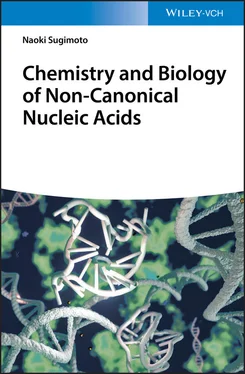1 Cover
2 Title Page Chemistry and Biology of Non-Canonical Nucleic Acids Naoki Sugimoto
3 Copyright Author Prof. Naoki Sugimoto Konan University Frontier Institute for Biomolecular Engineering 7-1-20 Minatojima-minamimachi 650-0047 Kobe Japan All books published by Wiley-VCH are carefully produced. Nevertheless, authors, editors, and publisher do not warrant the information contained in these books, including this book, to be free of errors. Readers are advised to keep in mind that statements, data, illustrations, procedural details, or other items may inadvertently be inaccurate. Library of Congress Card No.: applied for British Library Cataloguing-in-Publication Data A catalogue record for this book is available from the British Library. Bibliographic information published by the Deutsche Nationalbibliothek The Deutsche Nationalbibliothek lists this publication in the Deutsche Nationalbibliografie; detailed bibliographic data are available on the Internet at < http://dnb.d-nb.de >. © 2021 WILEY-VCH GmbH, Boschstr. 12, 69469 Weinheim, Germany All rights reserved (including those of translation into other languages). No part of this book may be reproduced in any form – by photoprinting, microfilm, or any other means – nor transmitted or translated into a machine language without written permission from the publishers. Registered names, trademarks, etc. used in this book, even when not specifically marked as such, are not to be considered unprotected by law. Print ISBN: 978-3-527-34521-2 ePDF ISBN: 978-3-527-81788-7 ePub ISBN: 978-3-527-81786-3 oBook ISBN: 978-3-527-81785-6
4 Preface
5 1 History for Canonical and Non-canonical Structures of Nucleic Acids 1.1 Introduction 1.2 History of Duplex 1.3 Non-Watson–Crick Base Pair 1.4 Nucleic Acid Structures Including Non-Watson–Crick Base Pairs 1.5 Perspective of the Research for Non-canonical Nucleic Acid Structures 1.6 Conclusion and Perspective References
6 2 Structures of Nucleic Acids Now 2.1 Introduction 2.2 Unusual Base Pairs in a Duplex 2.3 Non-canonical Backbone Shapes in DNA Duplex 2.4 Branched DNA with Junction 2.5 Multi-stranded DNA Helices 2.6 Structures in RNA 2.7 Conclusion References
7 3 Stability of Non-canonical Nucleic Acids 3.1 Introduction 3.2 Factors Influencing Stabilities of the Canonical Duplexes 3.3 Thermodynamic Analysis for the Formation of Duplex 3.4 Factors Influencing Stabilities of the Non-canonical Nucleic Acids 3.5 Thermodynamic Analysis for the Non-canonical Nucleic Acids 3.6 Conclusion References
8 4 Physicochemical Properties of Non-canonical Nucleic Acids 4.1 Introduction 4.2 Spectroscopic Properties of Non-canonical Nucleic Acids4.3 Chemical Interactions on Non-canonical Nucleic Acids 4.4 Chemical Platform on the Non-canonical Structures 4.5 Physicochemical Property of Non-canonical Nucleic Acids in Cell 4.6 Conclusion References
9 5 Telomere 5.1 Introduction 5.2 Structural Properties of Telomere 5.3 Biological Relevance of Telomere G4 5.4 Other Non-canonical Structures Related to Telomere Region 5.5 Conclusion References
10 6 Transcription 6.1 Introduction 6.2 Transcription Process 6.3 Transcription Process Perturbed by Certain Sequences of DNA and RNA 6.4 Transcription Process Perturbed by Non-canonical Structures of DNA and RNA 6.5 Conclusion References
11 7 Translation 7.1 Introduction 7.2 RNAs Involved in Translation Machinery 7.3 General Process of Translation 7.4 RNA Structures Affecting Translation Reaction 7.5 Conclusion References
12 8 Replication 8.1 Introduction 8.2 Replication Machineries 8.3 Replication Initiation 8.4 DNA Strand Elongation 8.5 Termination of Replication 8.6 Chemistry of the Replication and Its Regulation 8.7 Conclusion References
13 9 Helicase 9.1 Introduction 9.2 Function and Structure of Helicases 9.3 Unwinding of Non-canonical DNA Structures by Helicases 9.4 G4 Helicases in Gene Expressions 9.5 G4 Helicases in Replication 9.6 G4 Helicases in Telomere Maintenance 9.7 Relation to Diseases by Loss of G4 Helicases 9.8 Insight into Specific Properties of Activities of G4 Helicase Under Cellular Conditions 9.9 Conclusion References
14 10 Dynamic Regulation of Biosystems by Nucleic Acids with Non-canonical Structures 10.1 Introduction 10.2 Time Scale of Biological Reactions 10.3 Processes in the Central Dogma Affected by Dynamics of Nucleic Acid Structures 10.4 Conclusion References
15 11 Cancer and Nucleic Acid Structures 11.1 Introduction 11.2 Detail Mechanism of Cancer 11.3 Non-canonical Structures of Nucleic Acids in Cancer Cells 11.4 Roles of Non-canonical Structures of Nucleic Acids in Cancer Cells 11.5 Conclusion References
16 12 Neurodegenerative Diseases and Nucleic Acid Structures 12.1 Introduction 12.2 Protein Aggregation-Induced Neurodegenerative Diseases 12.3 DNA Shows Key Role for Neurodegenerative Diseases 12.4 RNA Toxic Plays a Key Role for Neurological Diseases 12.5 Conclusion References
17 13 Therapeutic Applications 13.1 Introduction 13.2 Oligonucleotide Therapeutics 13.3 Non-canonical Nucleic Acid Structures as Therapeutic Targets 13.4 Non-canonical Nucleic Acid Materials for Inducing Non-canonical Structures 13.5 Conclusion References
18 14 Materials Science and Nanotechnology of Nucleic Acids 14.1 Introduction 14.2 Non-canonical Structure-Based Nanomaterials Resembling Protein Functions 14.3 Protein Engineering Using G4-Binding Protein 14.4 Regulation of Gene Expression by G4-Inducing Materials 14.5 Environmental Sensing 14.6 Conclusion References
19 15 Future Outlook for Chemistry and Biology of Non-canonical Nucleic Acids 15.1 Introduction 15.2 Exploring Potential: Properties of Non-canonical Structures in Unusual Media 15.3 Systemizing Properties: Prediction of the Formation of Non-canonical Nucleic Acids Structures 15.4 Advancing Technology: Applications of Non-canonical Structures Taking Concurrent Reactions into Account 15.5 Conclusion References
20 Index
21 End User License Agreement
1 Chapter 2 Table 2.1 Thermodynamic parameters for duplex formations in 1M NaCl by DNA ol... Table 2.2 Free energy increments for tandem mismatches in RNA oligonucleotide...
2 Chapter 4Table 4.1 Hydration of G4 structures and duplexes.Table 4.2 Effects of molecular crowding reagents on stability and topology of...
3 Chapter 5Table 5.1 Human telomeric G4 structures available in the Protein Data Bank.
4 Chapter 6Table 6.1 Transcription process perturbs by non-canonical DNA.
5 Chapter 9Table 9.1 Helicases related to G4 unwinding.Table 9.2 Helicase related to human diseases.
6 Chapter 11Table 11.1 DNA and RNA G-quadruplexes related with cancer activation.
7 Chapter 12Table 12.1 Repeat expansion-related neurodegenerative disease.
8 Chapter 13Table 13.1 Oligonucleotide therapeutics approved in market.
9 Chapter 14Table 14.1 Representative list of DNA and RNA aptamers containing G4-forming ...Table 14.2 G4 structures located within mRNA 5′ untranslated regions shown ex...
10 Chapter 15Table 15.1 Studies of structures and stability of nucleic acids in ionic liqu...
1 Chapter 1 Figure 1.1 The diffraction pattern of the canonical DNA duplex and its chemi... Figure 1.2 Chemical structures of base pairs via Watson–Crick or Hoogsteen t...
2 Chapter 2 Figure 2.1 Watson–Crick and Hoogsteen base pairs in double helix. Chemical s... Figure 2.2 Wobble base pairs in duplexes. Chemical structures of G-T (a), G-... Figure 2.3 Mismatched G-A and G-G base pairs observed in nucleic acid struct... Figure 2.4 Mismatched T-T, C-T, and C-C base pairs observed in nucleic acid ... Figure 2.5 Structures of A-type (PDB ID: 3V9D) (a) and Z-type (PDB ID: 4OCB)... Figure 2.6 Structure of four-way junction to form cruciform and Holliday jun... Figure 2.7 Typical structures of multi-stranded DNA helices. (a) Canonical d... Figure 2.8 Hairpin structure. (a) General secondary structure of hairpin. (b... Figure 2.9 Bulge structure. (a) General secondary structure of bulge. (b) Se... Figure 2.10 Internal loop structure. (a) General secondary structure of inte... Figure 2.11 Distribution of RNA tertiary motifs except coaxial stacking of h... Figure 2.12 A-minor interactions. Examples of hydrogen bonding patterns of c... Figure 2.13 Ribose zipper interactions in tertiary structure of group I intr... Figure 2.14 T-loop motifs. (a) General secondary structure of T-loop motif c... Figure 2.15 Kissing-loop interaction. (a) General secondary structure of kis... Figure 2.16 Tetraloop receptor interaction. (a) General secondary structure ... Figure 2.17 Pseudoknot structure. (a) Base pairing patterns on the primary s...
Читать дальше












